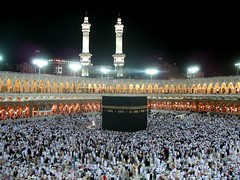When most people hear Islam, a stereotype might pop into mind. Perhaps you see people who wear turbans, or clothing very different from ours. Some may revert to the attacks on 9/11 as Jamie talked about in her post. For me, I knew a stereotype popped into my head, but I realized that most of what I thought was actually ignorance, lack of knowledge on the subject.
Islam is very similar to Christianity. According to what we talked about in class, they have five articles of faith. 1.) belief in one god, or Allah. 2.) Believe in angels as bearers of Divine revelation. 3.) Belief in old and new testament
4.) belief in validity of previous prophets such as Moses, and Abraham. Finally, Islam believes in the coming of the final judgment day. Like Christianity, they also have a book by which they abide. Where Christians have the bible, Islamic people have the Qur'an which are revelations about what people are supposed to do at certain times. Muslims, people who adhere to the Islamic faith also believe Muhammad, the prophet of Allah, is the seal of God. In class, my professor explained this as such: where the other religions had failed God, the Islamic faith and followers would not, and Muhammad was thus the last prophet from God, because they would not fail.
In the Islamic faith, there are also five pillars. First, there is daily prayer, five times a day. Second, is fasting during Ramadan. Next, is charity (tithe) and last is a pilgrimage to Mecca or Haji.
As much as it is a religion, or a following, it is also a system of social organization. As stated earlier, the Qur'an is a book of revelations of what people should do in certain instances. Along with this, there is the Hadith, which are stories about the life of Muhammad. However, these alone cannot rule or lead a people alone, and so Sharia was created: which is a code of Islamic law. According to my notes, this extends ritual law to all aspects of human life. So, it is essentially how to apply teachings to everyday life.
Within Islam, there are to sects, or types is another way to put it. You may have heard of the Shia, and the Suni. These are basically two different followings of one religion. The split happened when Ali, Muhammad's son in law did not receive the honor of being the first caliph, or deputy after Muhammad's death. It instead went to Ali Bakr. The division begun here. Long story short, Ali was very angry he was not elected as the first caliph. He was later made the fourth caliph, however conflicts arose, and Ali and a vast majority of his followers were assassinated. Those who survived became the sect of the Shia, and follow Ali and the dynastic ideas. (A fancy way to say they believed in the rule of the dynasty, that the successor of an empire should be a son or close relative of the previous empire.
The other sect, the Suni (Which is the majority of the Islamic following) Follows Abu (the first caliph talked about earlier) and the idea that whoever is most capable to lead, should.
Islam in my mind is a different form of Christianity. I find the ideas of Islam, and it's pillars to make a lot of sense, and I have a greater understanding of the faith. I was very intrigued to find Islam is also a social structure, as well as a religion. I hope my post has given you a different idea of Islam, and perhaps changed a stereotype.

